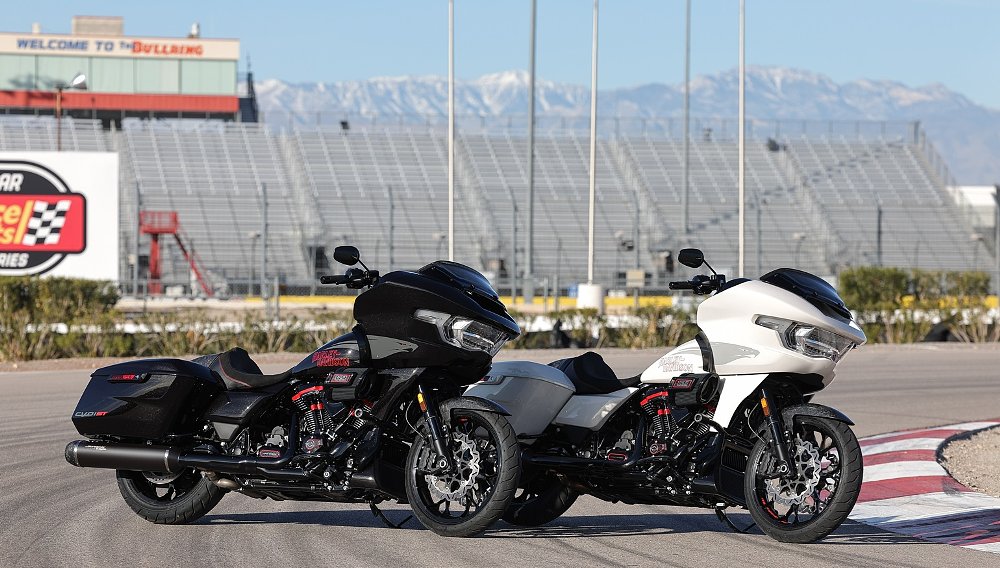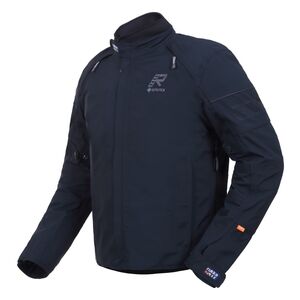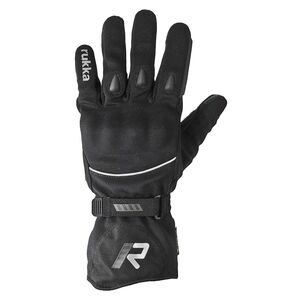There are plenty of good ways to leave Las Vegas, I'm sure, but as I rolled south on U.S. 95, I was glad — for a few reasons — to be leaving on a new 2024 Harley-Davidson Street Glide in Sharkskin Blue.
Partly that's because it was a chilly and gray February morning with at least a chance of sprinkles, and the Street Glide's batwing fairing, carefully redone by Harley-Davidson's designers after more than half a century without major changes, was protecting me from the chill. But I was also really glad to have two days to take a meandering route from Vegas to the RevZilla West office in Carson, California, to drop off the Street Glide for my West Coast colleagues. Some of the other writers who flew to Vegas to test the new Street Glide and Road Glide (plus the CVO Road Glide ST I wrote about earlier) didn't get any meaningful time on the the Street and Road Glides because Harley-Davidson cut short our test ride due to rain. And of course the most obvious reason I was glad: Two days to take the scenic route across the desert on a big American touring bike that's built specifically for one-up travels like that is a good assignment, when you can get it.
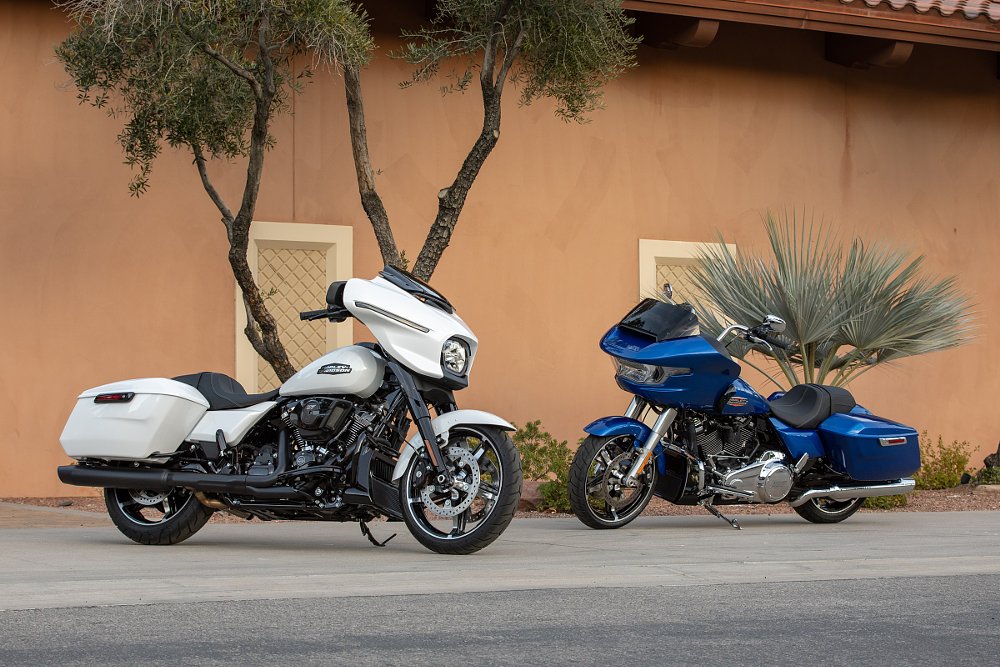
The 2024 Road Glide and Street Glide are the major new models Harley-Davidson has introduced this year. Harley-Davidson isn't soft-pedaling it, calling these models "the dawn of a new era." The Glides get an array of appearance changes and a reworked version of the Milwaukee-Eight 117 engine that makes 3% more horsepower and 4% more torque than the 2023 version. Harley-Davidson rates it at 105 horsepower at 4,600 rpm and 130 foot-pounds of torque at 3,250 rpm. Among the changes are a larger airbox and a smoothed intake tract for better airflow into the engine.
For both better performance and better rider comfort, the cooling system has been redesigned. The cylinders are air-cooled but the heads are liquid-cooled and coolant flow goes to the hotter rear cylinder head first and focuses on the exhaust valves. Engineers said the improved cooling allowed them to make a slight increase in the compression ratio, now 10.3:1 instead of 10.2:1.
Performance enhancements are always welcome, but the bigger story with the Street Glide and Road Glide is probably the aesthetic redesign. That's especially true with the Street Glide, with its fork-mounted batwing fairing that is a traditional and classic Harley-Davidson visual element. And if you know Harley-Davidson, you know it's a company that doesn't casually or carelessly tinker with tradition and classic looks. After more than 50 years largely unchanged, the new batwing fairing was unveiled last year on the limited-edition CVO Street Glide and now filters down to the regular model.
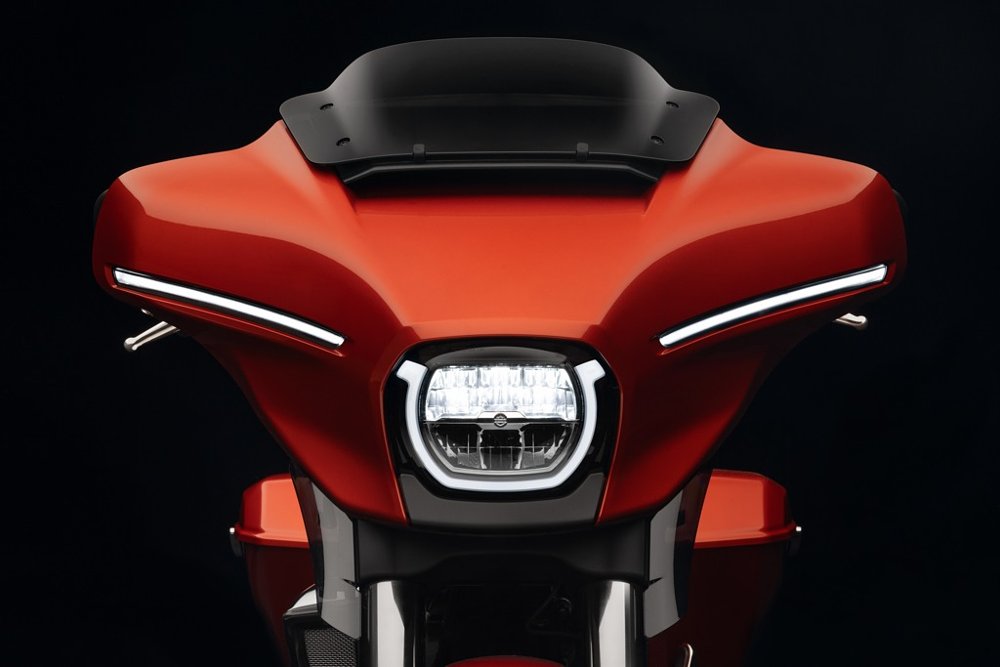
Functionally, the new fairing provides better airflow. Visually, it gets a more modern appearance without going so far that you don't recognize where it came from. Noticeable are the LED "omega-shaped" running light around the headlight and what Harley-Davidson designers call the "eagle-wing" light strips. Those LEDs incorporate the turn signals, so no more stalks protruding from the Street Glide. They also emphasize the shape of the fairing, whether in daylight or darkness.

The Road Glide fairing is also revised. Wrapped underneath and around the wide LED headlight is a running light that also incorporates turn signals.
Other subtle design changes were made to improve the lines of both bikes and give them a lighter appearance, from revised side panels to a new shape for the fuel tank. Again, for a company like Harley-Davidson, whose customers care about appearance and tradition, the designers have to sweat the details. Customers want a fresh look, but they also want the clear family resemblance.
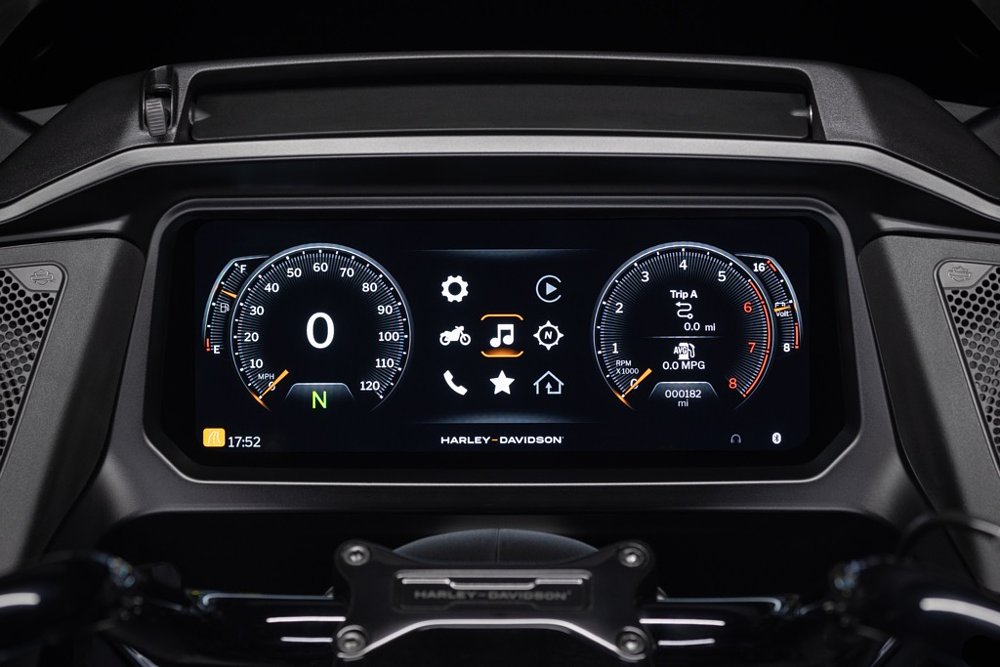
Once settled into the cockpit, the very visible change is the new 12.3-inch full-color touch screen display, which works with regular gloves. The rider can navigate through the menus either using the touch screen or the controls on the handlebar. Some touch screen features are disabled when the motorcycle is moving. Wi-fi connectivity allows real-time traffic updates and navigation and built-in Bluetooth allows a connection with a helmet headset. Three screen display options, labeled Cruise, Sport, and Tour, place different elements front and center on the screen. Navigation is emphasized in Tour, for example, or the tachometer in Sport.
The Glides also now have four ride modes that adjust the throttle response, engine braking, cornering-sensitive anti-lock brakes, and cornering-sensitive traction control. In addition to Road, Sport, and Rain modes, the rider can set a Custom mode by combining different levels of intervention from the electronic rider aids.
Finally, the Glides get an upgraded stereo with a more powerful 200-watt amplifier and two 5.25-inch speakers mounted in the fairing.
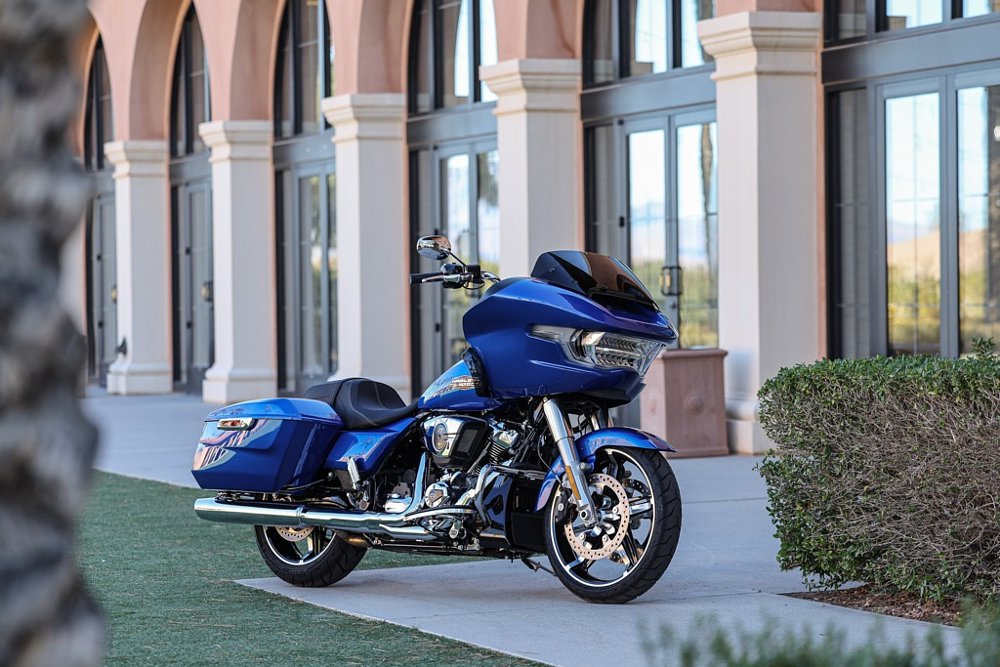
Harley-Davidson offers the Glides in eight different colors and most of them are available in two trims. Base price gets you Billiard Gray. Add $600 for Vivid Black or $850 for the premium colors, Blue Burst, Whiskey Fire, White Onyx Pearl, Alpine Green, Sharkskin Blue, and Atlas Silver Metallic. For most of those you can choose either chrome trim or, for an extra $1,350, the black trim, which adds black fork covers, exhausts, air intake, and engine covers. That range of options is refreshing in comparison to the take-it-or-leave-it lack of choices available with most motorcycle models.
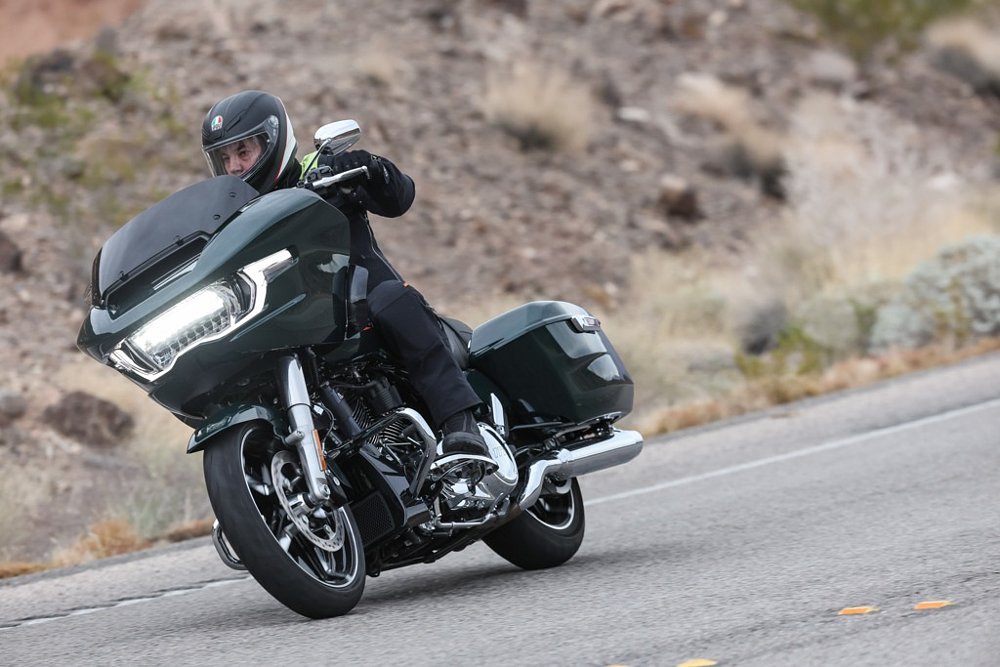
As I mentioned above, Harley-Davidson called off most of our original planned ride in the Las Vegas area. So if they hadn't offered to let me ride one of the bikes to the RevZilla West office, I wouldn't have been able to tell you anything about how the new Touring models work. But luckily I was able to spend a couple of days riding the Street Glide more than 500 miles on empty desert two-lanes, curvy mountain roads, and plenty of Southern California freeways in traffic.
Riding the 2024 Harley-Davidson Street Glide
Cutting straight south across the desert, U.S. 95 doesn't provide any curves, but it also doesn't impose much traffic. What it did provide, in my case, was an early opportunity to see how the redesigned batwing fairing works. Common Tread contributor Chris Force, who first tested it last year on the CVO model, and who has a lot more miles on Harley-Davidson touring bikes than I do, called the new fairing a massive improvement. It's been too long since I rode the previous version for me to attempt a back-to-back comparison, but the new fairing did do a good job of protecting me from the cool morning air. Airflow over the top of the short windscreen hit me about eyebrow level (I'm five feet, 11 inches tall). I had high expectations, and the wind noise was louder than I expected, but not bad. The designers incorporated an adjustable vent just above display and opening it significantly improves quietness and will also provide some cooling air on hot days. On social media, one reader wanted to know if the fork-mounted fairing put any vibration into the front end, and I have to say I never noticed any. I didn't encounter any serious crosswinds, so I can't say how the reshaped fairing would handle that.

U.S. 95 was also a good chance to try the Street Glide's cruise control, and quite simply it worked flawlessly. Easy to engage, easy to set, easy to adjust, all with just a button and a rocker switch on the top of the left handgrip switchgear pod.

As the terrain became more rolling, I found myself stuck several times behind semis on two-lane stretches where passing opportunities were limited. I was rolling along in Road mode, but that didn't stop me from hammering out a few passes in brief opportunities. For such circumstances, however, Sport mode does provide a reassuringly more aggressive throttle response and it's easy to switch. A flick of the right thumb and you can switch ride modes. No need to stop or close the throttle. Ride modes are sticky, so the next time you start the motorcycle, you'll have the same setting as before.

While Harley-Davidson trimmed a few pounds by shaving ounces here and there, the Street Glide is still a handful in a parking lot. Easing through small towns or pulling into a gas station where some suspiciously oily-looking puddles made me nervous, I was very careful to be mindful of the weight. Once moving, however, I was pleasantly impressed by how little input it takes to turn the motorcycle.
It wasn't until the second day that I hit the really nice curves around Julian, California. I set out early, the morning air was chilly, and damp patches lurked around most of the corners, so I wasn't throwing the Street Glide around like a sport bike on hot asphalt. The big bike felt stable but never heavy as I banked through the hills. This is what a one-up touring bike should be capable of doing: Keep you comfortable on the long ride, carry your essentials in waterproof safety, and still be able to dance — within reason — once you get to the hills. If you do spend a day on curvy roads, you won't be worn out from wrestling a hard-to-steer motorcycle.
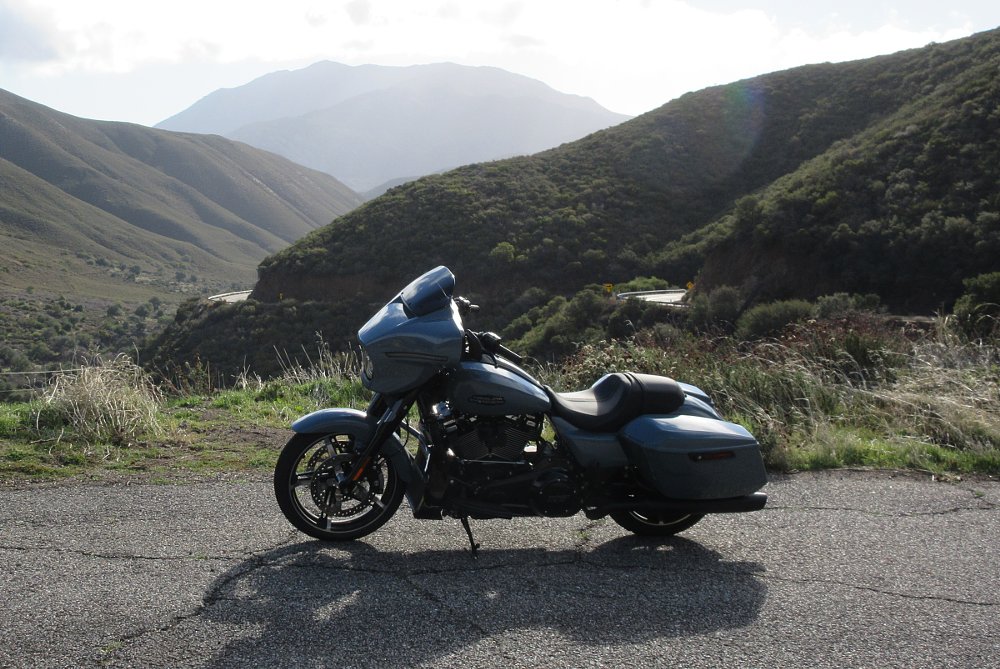
The brakes were typical modern Harley-Davidson, meaning they won't set records for being the most powerful but they get the job done, despite the weight they have to stop. My personal opinion is that the cable clutch reminds me far too much of the one on the 1991 Sportster I used to have, which cost a tiny fraction of today's Street Glide, and I think a 2024 Harley-Davidson clutch should have a smoother and lighter pull for a product from a company that uses the word "premium" a lot. Similarly, you want to be deliberate about shifting gears. Given the position of the shift lever floating above the floorboard, I found it easy to get sloppy and miss a shift. The combination of the stout clutch pull and gear-shift effort makes crawling traffic a bit of a pain in the (left) wrist.
Harley-Davidson increased the rear suspension travel by 50% — but that's still just three inches. I intentionally smacked into a few potholes and the Street Glide soaked them up better than most of the suspension-challenged cruisers I've ridden.
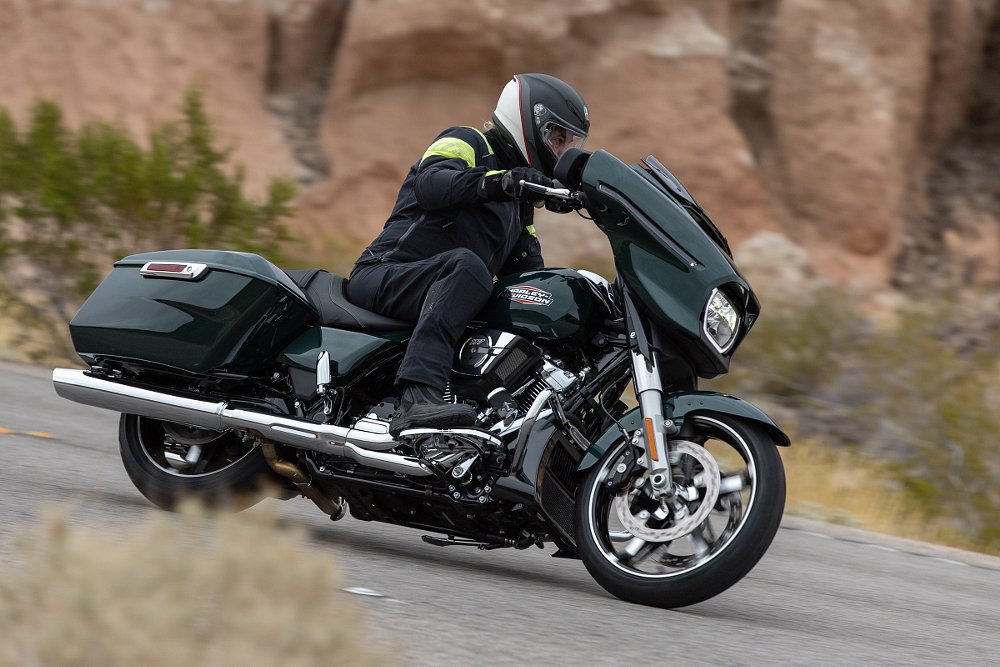
And then there's one more fundamental (pun intended) element for touring: the seat. I have to say that personally I really like the seat on the Street Glide, though I also recognize not everyone may agree. The reason I say that is because the seat locks you into one position, fore and aft. You can't slide forward much and the step at your back means you can't slide back. But for me, that one position was great. This is not a bike you're likely to be hanging off of, but the seat did let me shift weight side to side a little in the curves. And on the long highway drones, it was not too hard, not too soft, and kept me comfortable even when I rode for about four hours with only a couple of short stops.
I'm not sure I can rate the passenger seat as highly, however, though I'm just going by the way it looks. That's why above I referred to the Street Glide as suitable for one-up touring. The passenger seat looks like it would be fine for local rides, but if you're taking a two-up trip, you might want to visit the Harley-Davidson accessories catalog first.
The inevitable last part of my trip was riding into the Los Angeles area on the freeways. The Street Glide feels at home, running up the coastal highway, notched into sixth gear and spinning 3,000 rpm at an indicated 80 mph, just flowing with the Saturday traffic. You can still tell there's a V-twin down there, but there's no bothersome vibrations to wear you out.
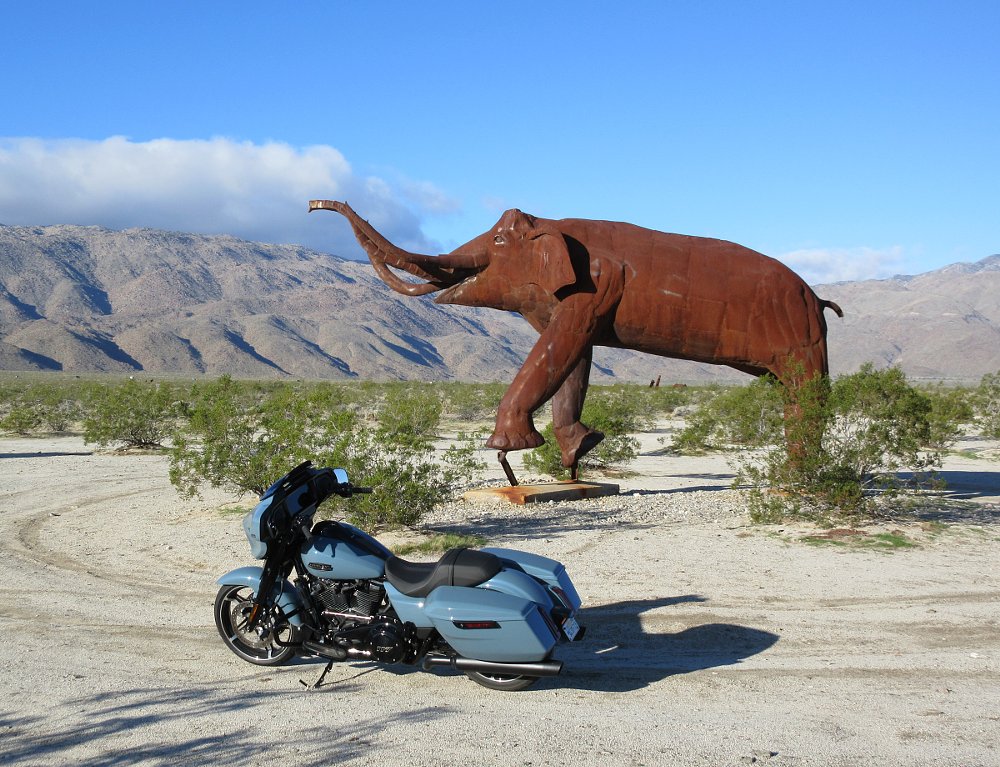
In two short days, I'd put the Street Glide through the range of riding any owner is likely to tackle. There are limits inherent to any motorcycle topping 800 pounds, but nothing that the Street Glide is intended to do that I'd say it didn't do well.
Road Glide or Street Glide?
Though I only rode the new Road Glide for 21 miles before the Harley-Davidson team canceled our ride due to rain, you probably don't even have to ride both models to decide which one you prefer. Mechanically, they are the same. They're available in the same colors and at the same price. Harley-Davidson PR Manager Paul James told me they sell in about equal numbers. So what's the difference between a Road Glide customer and a Street Glide customer? It mostly has to do with style, and a little with ergonomics.
Some passionate Harley-Davidson fans have strong opinions on the relative merits of the Road Glide's frame-mounted sharknose fairing versus the Street Glide's fork-mounted batwing fairing. Do you want your fairing to move when you turn the handlebar or not? Your opinion may be based on aesthetics, tradition, or simply what you're used to.
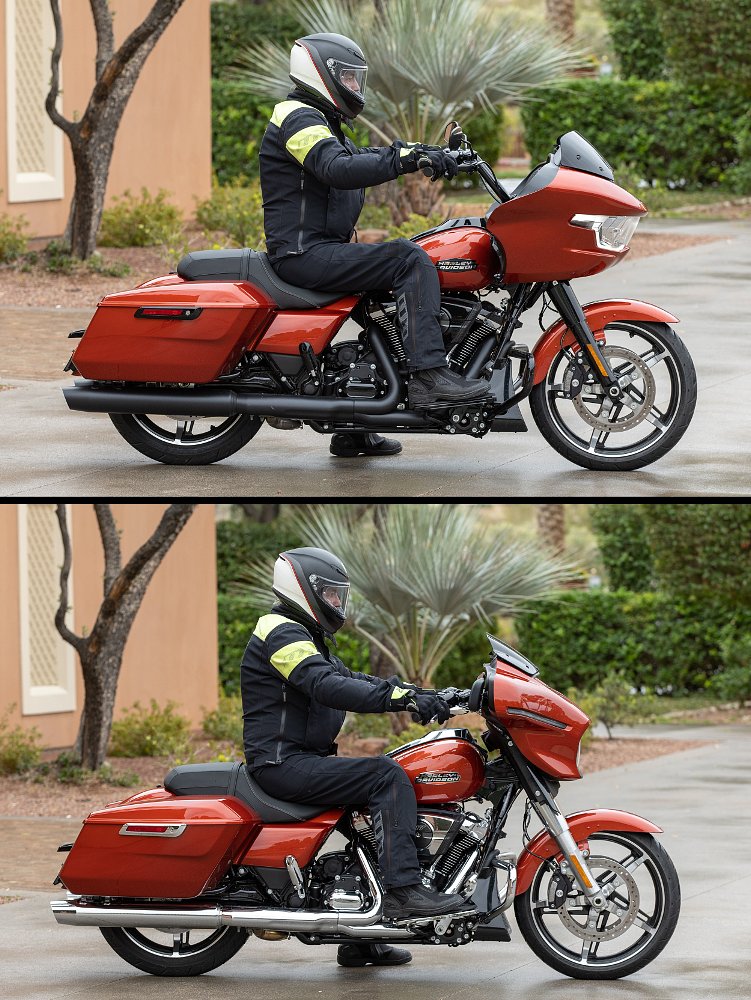
Beyond looks, however, there are some small but noticeable ergonomic differences. As you can see from the photo above, the greater rise in the Road Glide's handlebar means the rider's forearms are likely angled slightly up, not slightly down. More significantly, the Road Glide's fairing, including that touch screen, is much farther away. It may not matter, since you can navigate the menus on the screen using the handlebar-mounted controls. But the reach to the handgrips and the distance of the Road Glide fairing from the rider create a feeling of a roomier cockpit.
Speaking of ergonomics, both of these motorcycles seem to be built with extra-large humans in mind. For example, I have a 32-inch inseam, but when I was nestled back in that comfortable seat I had to stretch my leg as far as I could to reach the jiffy stand and retract it when taking off from a stop. A short rider would have to resort to some contortions. It's one more way, like the somewhat-heavy clutch pull, the firm tug required by the brake lever, and the overall weight of the motorcycle, that the Street Glide and Road Glide feel like they're made for burly riders whose other hobbies may include bear wrestling — and the Road Glide maybe 10% more so than the Street Glide.

Is this the new era?
Harley-Davidson is putting real emphasis on the new Street Glide and Road Glide with the "new era" talk. There's no doubt that for a company that relies so heavily on tradition and appearance, redesigning the batwing fairing, in particular, is a high-stakes change. I'll leave it to you to decide if some engine tweaks and new fairings constitute a new era, or just the sort of constant improvement every company should strive for with its products. As I've learned firsthand, questions of what looks and feels right and what a motorcycle is worth are very personal ones. And I got a clear reminder of that on my second day of riding the Street Glide.
I was stopped at a gas station in Ramona, California, and the guy on the other side of the pump — also a graybeard, but not as gray as me — politely waited until I finished and then asked about the Street Glide. I explained it was the new 2024 model, and pointed out a few of the significant changes as he circled the motorcycle with interest. He mentioned he rides a 2019 Road King.
Then he came to the natural question. "What's it cost?" Considering that a Street Glide costs well more than double what I've ever paid for a motorcycle, I was curious what his response would be when I told him the starting price was $26,000. Would that dampen his enthusiasm?
Hardly. He excitedly called his wife over. "This is what we're going to trade in our bike on," he told her.
Make what you want of a sample size of one, but call that one encounter, at least, mission accomplished for the 2024 Harley-Davidson Street Glide.
|
2024 Harley-Davidson Street Glide |
2024 Harley-Davidson Road Glide |
|
|---|---|---|
| Price (MSRP) | $25,999 | |
| Engine | Milwaukee-Eight 117 1,923 cc, eight-valve, V-twin | |
|
Transmission, final drive |
Six-speed, belt | |
| Claimed horsepower | 105 @ 4,600 rpm | |
| Claimed torque | 130 foot-pounds | |
| Frame | Steel tubular | |
| Front suspension | 49 mm Dual Bending Valve; 4.6 inches of travel | |
| Rear suspension | Dual shocks adjustable for preload; 3.0 inches of travel | |
| Front brake | Dual four-piston calipers, 320 mm discs, with ABS | |
| Rear brake | Single-piston caliper, 300 mm disc, with ABS | |
| Rake, trail | 29.25 degrees, 6.7 inches | 26 degrees, 6.8 inches |
| Wheelbase | 64 inches | |
| Seat height | 28.1 inches | 28.3 inches |
| Fuel capacity | 6.0 gallons | |
| Tires | Dunlop D408F 130/60B19 front, D407T 180/55B18 rear | |
| Claimed weight | 811 pounds wet | 838 pounds wet |
| Available | Now | |
| Warranty | 24 months | |
| More info | harley-davidson.com | harley-davidson.com |

 Membership
Membership









